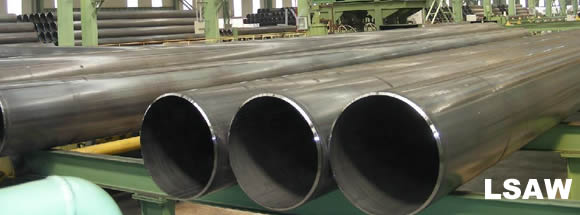
What is LSAW and SSAW Pipe?
An LSAW pipe (“submerged arc welding”) is manufactured by cutting, bending, and welding steel plates (JCOE process). The two main types of LSAW pipes are the longitudinal (with a single or double straight seam weld, DSAW) and the spiral type (called, HSAW, SSAW or SAWL pipe).

Spiral steel pipes (SSAW Pipe) and straight seam steel pipes are currently widely used in water pipelines, construction and other industries, but there is a big difference between the two.
1. Different pressure-bearing capacity
The strength of spiral steel pipes is generally higher than that of straight seam steel pipes. The main production process is submerged arc welding. Spiral steel pipes can use blanks of the same width to produce steel pipes with different pipe diameters, and can also use narrower blanks to produce steel pipes with larger pipe diameters.
2. Different specifications
The specifications of spiral steel pipes are generally above 219mm, and most of them are of large diameter. The specifications of straight seam steel pipes are mostly of small diameter, but some manufacturers also have many large diameters.
3. Different prices
Spiral steel pipes are mostly settled by measuring rulers, and the price of straight seam steel pipes is mostly settled by weighing, but the price of spiral steel pipe is about 300 yuan/ton cheaper than that of straight seam steel pipe.
4. Different manufacturing processes
LSAW (Longitudinal Submerged Arc Welded)
It is made by welding steel plates longitudinally, and generally uses UOE, JCOE and other forming processes.
Features: straight seam welding.
SSAW (Spiral Submerged Arc Welded)
The hot rolled coil is welded after forming at a spiral angle, and the weld is distributed in a spiral shape.
Features: Spiral weld.
5. Different weld types
LSAW: Straight weld, along the axis of the pipe.
SSAW: Spiral weld, wrapped around the pipe at an oblique angle.
6. Different strengths and quality control
LSAW: Short weld, easy for flaw detection, more stable and reliable quality;
Suitable for high pressure, large diameter, key structure projects.
SSAW: Long welds with more potential weld defects;
Slightly lower strength than LSAW, but cheaper to manufacture.
7. Different application ranges
LSAW: Commonly used in high-demand situations such as long-distance high-pressure oil and gas transportation and structural support projects.
SSAW: Widely used in low-pressure fluid transportation, urban pipelines, infrastructure, etc.
8. Market prospects
In terms of market prospects, LSAW pipes are expected to see greater development space in high-end demand areas as the energy transmission and construction industries develop; SSAW pipes will consolidate their position in the medium and low pressure large diameter transportation market through technological upgrades and seek broader application areas. The two are not substitutes for each other, but complement each other, jointly meeting the diverse needs of industrial production and infrastructure construction.
How to choose between LSAW and SSAW pipe?
When selecting between LSAW pipe and SSAW pipe, it’s important to evaluate the project’s technical and economic requirements to ensure the most suitable type of welded pipe is used.
1. Operating pressure:
For high-pressure oil and gas pipelines, LSAW pipes are preferred due to their straight welded seam, excellent mechanical strength, and superior reliability under extreme service conditions. Compared with ERW pipes, which are typically used for smaller diameters and moderate pressures, LSAW welded pipes can withstand higher internal stresses and provide longer service life.
2. Project budget:
If cost efficiency is a major concern, SSAW pipes offer a more economical choice. Their spiral welding process allows continuous production from steel coils, reducing material loss and manufacturing costs. They are well suited for low-pressure or non-critical systems such as water transmission and structural applications.
3. Pipeline length and diameter:
SSAW pipes provide greater flexibility in diameter and length, as the forming angle can be adjusted to produce large-diameter welded pipes continuously. This makes them practical for long-distance projects where fewer joints and faster installation are required.
4. Dimensional acuracy:
LSAW pipes deliver better roundness, straightness, and dimensional tolerance compared with SSAW or ERW pipe. This precision ensures a tight fit and easier alignment during field welding, which is essential in projects that demand high construction quality.
With the continuous advancement of science and technology and the continuous changes in market demand, manufacturers of LSAW pipes and SSAW pipes should continue to increase investment in technological innovation and R&D to improve product quality and performance to adapt to market development trends.
Read more: Difference between Spiral Steel Pipe and LSAW Steel Pipe


